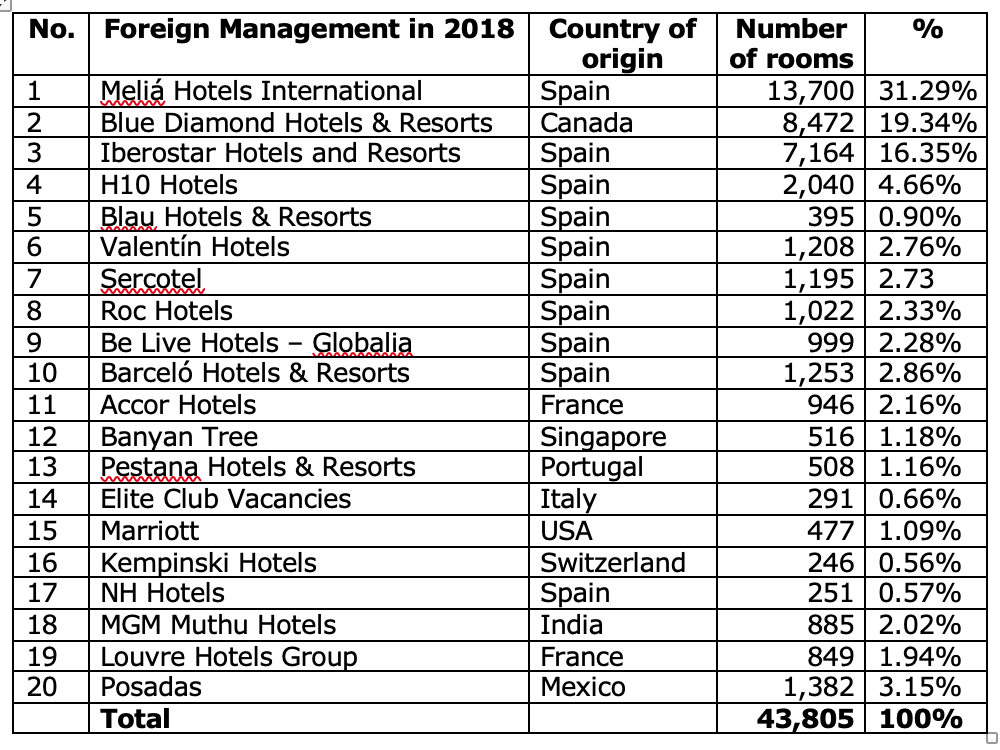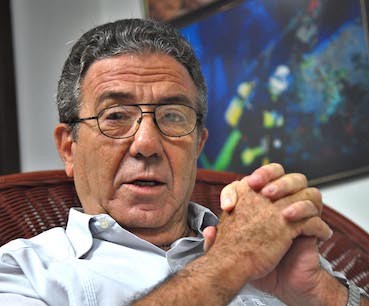Foreign Participation in the Development of Tourism in Cuba
Tourism has not been the sector that has received the highest volume of foreign investment in Cuba. The numbers show otherwise.

In the development of tourism in Cuba, it was a strategic and intelligent decision to open new opportunities to international hotel chains that have strong operational ties to large tour operators and international airlines.
The chain Sol Meliá, based in Majorca, Spain was the first to enter the island, led by an investor from the Canary Islands who invested in three new joint venture hotels in Varadero.
A little more than a decade later, 17 international hotel chains had entered into hotel administration contracts, covering 51 hotels with 18,474 rooms (45% of all available rooms in Cuba). The list includes hotel chains from Spain, Jamaica, Germany, France, and Italy.
In the past 30 years, the pattern of foreign companies managing hotels has grown continuously, with Sol Meliá always in the leadership position.

Significance of Contracting with Foreign Hotel Chains
At the beginning of the 1990s, Cuba had management contracts for three hotels with an aggregate of 1,330 rooms. With the second decade of the 21st century coming to a close, 20 foreign companies manage and promote 118 hotels with an aggregate of 43,805 rooms. They manage almost two-thirds of the total number of existing hotel rooms at a variety of room rates, with the recently opened luxury hotels charging much higher room rates. The initial investment in those 118 hotels totals 5 billion Cuban Convertible Pesos (“CUC”).[1]
Between 1990 and 2018, capital invested by the Cuban partner pursuant to joint venture agreements totaled a few billion dollars. During that same period, the hotels administered by the foreign partners generated revenue of 16 billion CUC (and U.S. dollars) with a total capital investment by the foreign partner of approximately six percent (6%) of the total revenue.
Moving fearlessly forward in signing hotel administration contracts was indisputably a wise and successful policy that brought large benefits to Cuba and has turned out to be beneficial for the foreign hotel management chains.
In a short time period, Cubans acquired knowledge and skills in hotel administration from the foreign management company partners. The Cuban vacation offerings were publicized via these companies’ promotional and sales channels. Those foreign partners form part of enormous tourism networks comprised of travel agencies linked to big tour operators and world-wide hotel chains. All of which led to the initiation of new flights to Cuba by foreign airlines so that currently 68 international airlines link Cuba with 70 cities around the world.
Management Companies Enter and Leave Cuba
During 29 years of successful operations under this management model, more than 300 contracts were signed in Cuba. Some hotels have operated under five or six different management contracts, as successor companies have assumed the arrangements. Other hotel companies enter the Cuban market, operate during a period of time and then leave.
During these past three decades, almost all of the capital for financing Cuban tourism development has come from State resources. Foreign capital represents approximately two percent (2%) of all funds dedicated to the Cuban tourist sector.
When the foreign management companies began their tenures in Cuba, they would place at each hotel, from their own ranks, between 15 and 20 managers and other key hotel staff. This was consistent with their method of operation in other developing nations.
Once they perceived the Cuban workforce’s high education levels, qualifications and rapid assimilation of knowledge, the foreign managers and owners began to reduce the number of foreign personnel assigned to Cuban properties. Foreign workers are expensive for the Cuban partner: they earn more money than a native worker and the Cuban partner is required to provide them and their families with housing and medical care and pay for their vacations and transportation costs to their home country.
Workers in the Cuban tourism sector are well-educated, with 70% having more than a 12th grade education. There are approximately 20,000 university graduates working in the sector. These educational levels are not typical in the industry in other underdeveloped countries. Hotel management chains with prior experience tend to place in Cuba only three or four workers from abroad. Generally in those cases, the foreign workers are the general manager, the manager for food and drinks and one or two high quality chefs who also have good administrative skills.
Hotel Joint Ventures
Between 1990 and 2005, 14 hotels with an aggregate of 5,000 rooms went into operation under the ownership of joint enterprises financed, with a combination of foreign and Cuban capital, totaling 500 million CUC. If the foreign investment equaled 50% of the equity in the venture, then the total value of the foreign investment was 250 million CUC.
Back then, an initiative called Cien Amigos (“One Hundred Friends”) was created: Cuban companies would finance the total cost of hotel construction and then would sell half of their shares in the completed hotel to the foreign partner. Only two Cien Amigos hotels were built under this model. Although it seemed to Cubans like a good idea, these arrangements did not create the desired results and only two to three percent (2-3%) of the shares in these hotels were actually purchased by the foreign partners and, thus, the foreign equity capital in these ventures was minimal.
In the 29 years during which more than 5 billion CUC were invested in new hotel construction or renovation, foreign capital contributed a modest four percent (4%) to the total. If one aggregates all of the investment in related infrastructure, in which there was no foreign investment, one can calculate that foreign capital represented just two percent (2%) of all investment made in Cuban tourism. Almost all hotel investment has been financed from Cuban capital.
It is erroneously and commonly noted that tourism is one of the sectors in Cuba that has received the most foreign investment. As noted above, foreign investment flows have had minimal impact on the development of international tourism in Cuba.
Earlier, between 1990 and 2004, many hotels were built with a tourism development fund that was administered effectively. With that, the MINTUR (Ministry of Tourism) built dozens of hotels, occasionally using a joint venture structure. When the firm Gaviota, a member of the Business Group of the Revolutionary Armed Forces (“Grupo Empresarial de las FAR”), entered the tourism industry in greater force beginning in 2004, the funds for hotel construction in the most attractive areas—such as Varadero, Cayo Santa María, the keys north of Ciego de Ávila, and Holguín—came from their own resources.
Although Meliá Hotels manages five hotels through joint enterprises, they have made minimal capital investments: Meliá continues to operate primarily as a manager. On the other hand, Iberostar is party to 19 hotel administration contracts, including four hotel joint ventures, in which it is a 50% owner.
Seven hotel joint ventures are located in Varadero, representing half of all hotel joint ventures in Cuba. Three hotel joint ventures are located in Havana, two in Cayo Coco, one in Jibacoa and another in Trinidad. Some foreign investors contributed capital to these joint ventures initially; later, they sold their shares in the ventures to other foreign entities.
In May of 2017, during the South American Hotel and Tourism Investment Conference held in Havana, it was announced that the state-owned company CUBANACAN has nine hotel joint enterprises in progress.
Financing Investments
Part of the funds obtained by Cuba for tourism development have been obtained through international credits backed by the international chains that operate in Cuba. This has been the case since the beginning of the foreign investment process in Cuban tourism. Recently, two large lines of credit were obtained for renovations to the Habana Riviera and Habana Libre hotels.
Golf
Ten years ago, the Cuban government instructed MINTUR (the Ministry of Tourism) to enter into joint ventures to develop real estate with modern golf courses. None of those developments have yet been built. It has been necessary to eliminate obstacles presented by Cuban legislation regarding who has title to land and other issues related to development by foreign investors. Currently, negotiations continue for the creation of five or six joint ventures to develop golf courses.
Construction Joint Ventures
Since the 1990s, Cuban state entities have entered into short-term joint ventures with foreign construction companies to build new hotels. As is commonly known, Cuba began by using foreign contractors because it then lacked knowledge and expertise in this competitive field. Once it developed local expertise through these arrangements, new national projects were completed by Cuban architecture and engineering firms.

Conclusion
Foreign participation in the development of international tourism in Cuba has been key in four aspects:
- In developing hotel management skills.
- In obtaining foreign credits for Cuban entities.
- In developing hotel construction expertise.
- In attracting tourism to Cuba by means of the international hotel chains.
During these past three decades, almost all of the capital for financing Cuban tourism development has come from State resources. Foreign capital represents approximately two percent (2%) of all funds dedicated to the Cuban tourist sector, and it is primarily invested in Cuba’s 14 joint venture hotels.
The amount of foreign investment in Cuba’s private tourist sector from friends and family abroad, as well as from undeclared foreign partners has not been tallied; but it is substantial. In 2019, there were 26,224 quality private rooms for rent, good private restaurants and hundreds of reconstructed automobiles available for tours.
A tentative calculation is that the capital investment from abroad in the private sector is somewhere around 500 million CUC. In other words, it is probably double the total foreign investment in the Cuban state tourist sector to date.
This is a version of an article published originally in Progreso Semanal: https://progresosemanal.us/20191003/la-participacion-extranjera-en-el-desarrollo-del-turismo-cubano/
Footnotes
[1] The Cuban Convertible Peso (CUC) currently has a fixed exchange rate of one to the U.S. dollar.

Miguel Alejandro Figueras Pérez is a Cuban economist with more than 50 years of experience in the field. Professor Figueras has a Bachelor's Degree in Economics and a Doctorate in Economic Sciences from the University of Havana where he is currently an Associate Professor and Senior Researcher.
MAF Tourism (EN) (ed) + Access.pdf 206.22 KB
